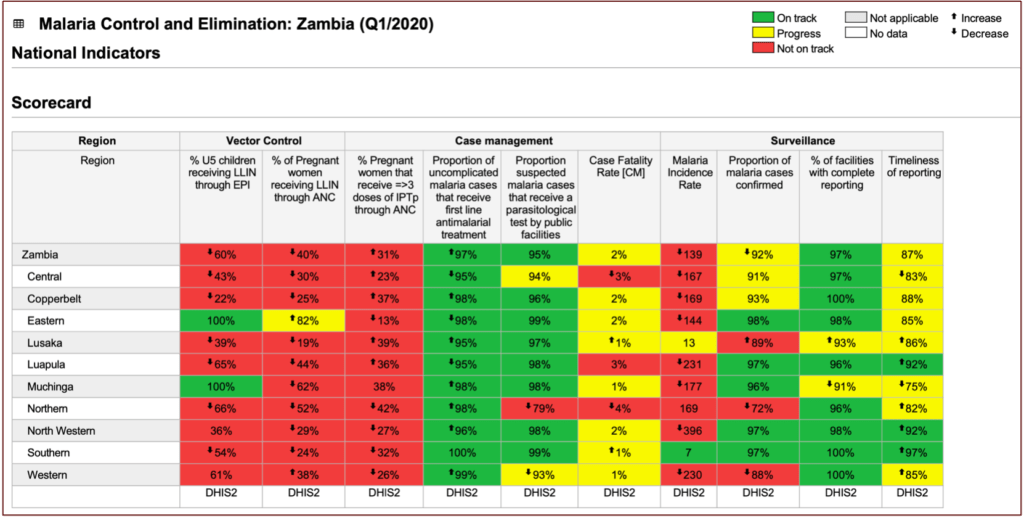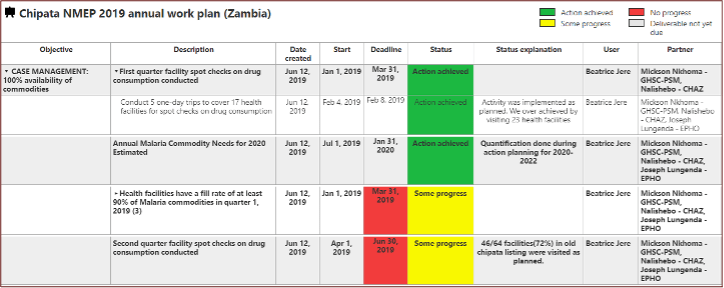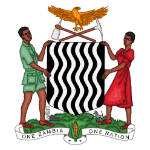A tool to help the country achieve elimination goals
The malaria burden in Zambia has decreased significantly with the scale-up of control efforts in the past decade. However, the disease is still a major public health challenge and remains endemic across all ten provinces. The country’s steady progress in the fight against malaria can be attributed to increased efforts by the Zambian government and partners, as well as the use of an innovative tool such as the malaria scorecard management tool.
Malaria scorecard management tools
Malaria country scorecard management tools have been rolled out in over 40 countries to help government and partners track progress against key malaria indicators nationally and sub-nationally and drive action. The scorecard tools are country-owned and reflect each country’s priorities and interventions.
The scorecard tool is populated using data from the country’s health management information system (HMIS) known as DHIS2. The scorecard tool is produced and hosted on ALMA’s Scorecard Web Platform. Every month, data is collected at facility level and submitted to the district health information officer who uploads it into the DHIS2. The web platform has in-built interoperability with DHIS2, enabling the scorecard tool to be easily populated through transferring data directly from DHIS2.
Performance is displayed on the scorecard tool using traffic light colour-coding, helping to identify bottlenecks quickly. When there is underperformance in the scorecard tool, actions are assigned in the Action Tracker to a particular individual. The Action Tracker allows users to track progress on action implementation. The action owner will receive automatic reminders telling them they are responsible for an action.

Malaria scorecard tool rollout in Zambia
Zambia first rolled out the malaria scorecard management tool in a joint effort by the Ministry of Health’s National Malaria Elimination Centre (NMEC) and partners. Partners included:
- African Leaders Malaria Alliance (ALMA)
- The Global Fund
- US President’s Malaria Initiative (PMI)
- World Health Organization (WHO)
- UNICEF
- PATH’s Malaria Control and Elimination Partnership in Africa (MACEPA)
- United States Agency for International Development (USAID)
- PMI’s Africa Indoor Residual Spraying Project (AIRS)
- Malaria Care
The Zambian Malaria Control and Elimination Scorecard tool is now used to generate and track actions through existing coordination mechanisms at both national and subnational level. For example, in Eastern province, the scorecard tool review and analysis revealed that 12 out of 14 districts were not on track for the proportion of pregnant women receiving long-lasting insecticide-treated nets through antenatal care indicator. Corrective action was taken and the Quarter 4, 2019 scorecard tool shows the progress made by the province with 12 districts on track.
The scorecard led to mobilised resources from local partners in the district for fuel to distribute nets.
Polite Zulu, Chipata District
Review of the scorecard management tools during management meetings
The Zambian Malaria Control and Elimination Scorecard tool is used to generate and track actions through existing coordination mechanisms at both national and subnational level. This includes ministry-level, programme-level, provincial-level and district-level.
Assignment of actions
When underperformance is identified while reviewing the scorecard tool, corrective actions can be assigned in the Action Tracker to a particular individual. The functionality allows for tracking progress on action implementation through an automated accountability system that will send notifications by SMS and email to the action owners, to ensure follow-up and implementation. The action owner can then update progress in the Action Tracker to ensure there is transparency and all parties are notified of progress or any delay and bottlenecks in implementation.

Indicators on Zambia’s malaria scorecard management tool
A total of 22 indicators were selected in 2016 for the monitoring and evaluation of malaria control and elimination in Zambia. These included:
- national priority indicators
- case management indicators
- vector control indictors
- surveillance monitoring and evaluation indicators
- program management indicators
These indicators were updated to align to the key performance indicators in the National Malaria Strategic Plan for 2011 to 2015 and the National Malaria Elimination Strategic Plan for 2017 to 2021.
| Categories | Indicators |
|---|---|
| Case management | Proportion of pregnant women attending antenatal care (ANC) that receive at least 3 doses of IPTp Proportion of uncomplicated malaria cases that receive first line antimalarial treatment Proportion suspected malaria cases that receive a parasitological test by public facilities · Case fatality rate [CM] |
| Vector control | Proportion of children under 1 year who receive long-lasting insecticidal nets (LLINs) under the Expanded Programme on Immunization (EPI) Proportion of women attending antenatal care (ANC) who receive long-lasting insecticidal nets (LLINs Proportion of eligible structures that received indoor residual spraying during the reporting period (not applicable for quarter 4, 2019) |
| Surveillance | Malaria incidence rate Proportion of malaria cases confirmed Proportion of facilities with complete reporting Timeliness of reporting |
Workplan Manager
The Workplan Manager is a new feature of the Scorecard Web Platform, rolled out in 2019. The Workplan Manager allows integration and alignment of all activities from government and partners. The feature enables the joint tracking of implementation of the annual workplan, listing key milestones and action items and progress against them.
This new functionality is designed to:
- provide National Malaria Elimination Program (NMEP) and Zambia’s End Malaria Council with a management tool that tracks national and sub-national performance to strengthen accountability and drive action
- enable decision-makers to have access to real-time information on the implementation progress of planned activities
- create a platform with key stakeholders and partners to allow cooperation
Why the Workplan Manager was implemented
The end term review of 2011 to 2015 in the 2016 Malaria Strategic Plan recorded an implementation and achievement rate of 36%. To avoid a repeat of this situation, Zambia included ‘increase the implementation rate of interventions from 36% in 2015 to 95% by 2018’ as a key objective in the 2017 to 2021 strategic plan.
The NMEP identified as a key strategy the development of an electronic management tool that would:
- facilitate the processes of translating the strategic plan into operational workplans
- allow workplans to be aligned at all levels and across all partner projects
- enable transparency through real-time tracking of progress
As a first step, the NMEC led in March 2018 the harmonisation of national and provincial workplans, in collaboration with provinces and partners. A decision was made to do the same in a cascade fashion to the district and health facility levels.
How the Workplan Manager works
Every year, the Workplan Manager is populated in the first quarter during the annual workplan harmonisation meeting. All stakeholders (government, provinces, districts and partners) use this process to align their workplans which in turn are used to:
- review performance
- identify and address bottlenecks
- drive action
Stakeholders can sign into the web platform to see progress and quickly identify delayed deliverables. The workplan is discussed at several meetings including:
- weekly management meetings at the province or district
- quarterly meetings at the district or province
- monthly directorate meetings at the NMEP
- quarterly meetings of Zambia’s End Malaria Council
For example, the Eastern Province has used the workplan during Malaria Taskforce Meetings to advocate for LLINs (bed nets) distribution successfully.

Impact
Political commitment
The scorecard tool is reviewed every quarter by Zambia’s End Malaria Council. The council is convened by the President of the Republic of Zambia and chaired by the Minister of Health. Comprised of representatives from government, business and the community, 16 members currently sit on the council.
The scorecard tool helps to review progress and activities, and to discuss solutions to resolve bottlenecks. For example, in October 2019, the NMEC presented the scorecard tool and highlighted that one indicator was underperforming (pregnant women receiving 3 doses of IPTp during antenatal care) due to a stock out of the drug sulphurdoxine-pyrimethamine.
Commitments following the meetings were made and by the next meeting it was confirmed that 2,450 tins of sulfadoxine-pyrimethamine worth US$ 230,000 were received and distributed to the provinces. The US President’s Malaria Initiative was also present at the meeting. They had a long-standing policy of not procuring sulfadoxine-pyrimethamine. After acknowledging the urgency, they changed their policy towards sulfadoxine-pyrimethamine procurement.
Service delivery
In Kapiri-Mposhi District in Central Province, the scorecard review in quarter 3, 2017 showed that the proportion of suspected malaria cases that received a parasitological test was low. An investigation of the issue revealed that there was stock-out of rapid diagnostic tests (RDTs). As a response, RDT’s were sourced. Management has since noted that since quarter 3, 2017, there have been little to no cases of clinical malaria in the district.
Data quality
The scorecard management tool has proved to be an asset in strengthening service delivery and data quality. In Chembe District in Luapula Province, the Provincial Health Office observed a sudden increase in incidence rate in the scorecard tool which led to a data audit. The audit identified discrepancies that were attributed to one facility that was over-reporting.
Stakeholder coordination
Following the introduction of the Workplan Manager, partners and government officials have indicated that stakeholder coordination has significantly improved. For example, the integration of the partners’ workplans with the district health management team has made it possible to coordinate activities. The activities include:
- training of community champions in rectal artesunate
- distributing logistics to eliminate malaria in Chitambo District of Central Province, which was not possible in the past
- partners providing support for advocacy meetings with community leaders and chiefs in the Southern Province
Success story: Workplan Manager helps operational workplan implementation rate
A review of the 2019 NMEP workplan shows that out of 104 workplan activities, 84 were implemented, giving an overall implementation rate of 80.8%. This suggests there has been a significant increase in Zambia’s 2019 operational plan implementation rate compared to the average of 36% achieved at the end of the 6-year implementation of the national malaria strategic plan for 2011 to 2015, extended to 2016.
The introduction of the Workplan Manager has strengthened partner coordination and improved joint reporting. The tool is reviewed every month by all parties to monitor progress and identify bottlenecks. This helps avoid duplication, such as:
- monitoring of the availability of malaria commodities at all levels of the supply chain
- improving transparency over malaria work at all levels
During an independent evaluation in 2019, partners said that the Workplan Manager has helped to avoid duplication of work. For example, avoiding visiting the same facilities during data collection.
